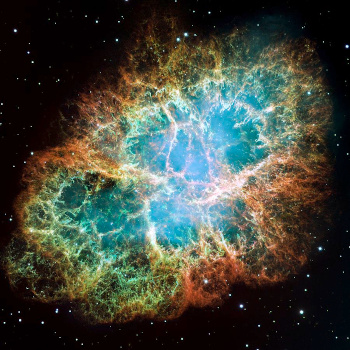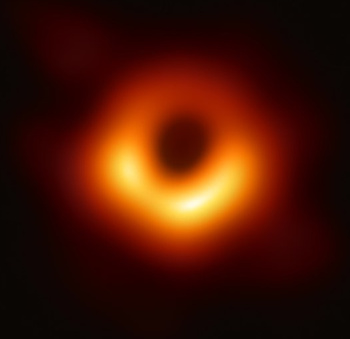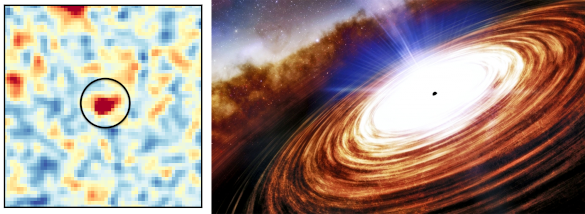Most Distant Quasar
March 1, 2021
The
universe is a large place. As
astronomers have been able to examine its contained objects more closely with improved
imaging technologies, some of the discovered objects are so strange that they took a long time to explain. One such object is the
quasar, a
contraction of the term, "quasi-stellar object," so-called because these had features, such as compactness, similar to
stars, and other properties, such as
luminosity, quite unlike stars. The five year old
daughter of
husband and
wife astronomers and quasar observers,
Margaret Burbidge (1919-2020) and
Geoffrey Burbidge (1925-2010), is said to have called these objects of her parents' studies,
crazy stellar objects, which is an apt naming.[1]

Margaret Burbidge receiving the 1983 National Medal of Science from US President, Ronald Reagan.
Burbidge is best known as an author of the 108 page "B2FH paper" in Reviews of Modern Physics, named after its authors, the two Burbidges, William A. Fowler (1911-1995), and Fred Hoyle (1915-2001).[2]
In 1976, Burbidge became the first female president of the American Astronomical Society. That was after her 1971 refusal of its Annie Jump Cannon Award, an award designated for women astronomers. Said Burbidge, "It is high time that discrimination in favor of, as well as against, women in professional life be removed."
(US government image, captured from a YouTube Video by the Women's Museum of California.[3] Click for larger image.)
Quasars were first detected by
radio astronomers shortly after
radio astronomy became an established
scientific discipline enabled by advancements in
microwave radar during
World War II. Radio astronomers detected a few objects emitting large amounts of
radio energy that did not seem to be matched with an
optical image. This was not surprising at first, since the pointing
accuracy of early
radio telescopes was not that good. In some cases, a match was found with a
point-like object that resembled a distant star.
Finally, in 1963,
Allan Sandage (1926-2010), a pioneer in optical imaging of distant
galaxies, and his
colleagues matched a faint
blue star with one such radio source,
3C 48. The
optical spectrum, which at first resisted interpretation, turned out to be the highly
redshifted spectrum of
hydrogen. This led to the further problem that the large distance associated with this, and similar, objects, as
calculated from the
cosmological redshift, made them much more luminous than any galaxy. Furthermore, they were found to be more compact than galaxies, since their
brightness varied on
yearly timescales. This meant that their light came from a region less than about a
light year in size. Our own
Milky Way galaxy is about 185,000 light years in
diameter.
The redshifted spectrum could not be denied, but there were immediate suggestions that, since the luminosity was so
intense, that the redshift was not cosmological, possibly arising from
light emission from a deep
gravitational well, so these objects were closer. It was also suggested that the
energy might derive from
antimatter annihilation, the emission was from the
white hole end of a
wormhole, or a
cascade of
supernovae in which each
explosion triggers others.

The Crab Nebula, a spectacular remnant of a supernova explosion.
The energy of such an explosion can exceed 1044 joules, which is why they were considered as a quasar energy source.
This composite image by the Hubble Space Telescope was assembled from twenty-four images.
Neutral oxygen is blue, singly-ionized sulfur is green, and doubly-ionized oxygen is red.
(Wikimedia Commons image by NASA, ESA, and J. Hester and A. Loll of Arizona State University.)
The current
scientific consensus is that the energy source of a quasar is a
supermassive black hole in a
galactic nucleus surrounded by a
gaseous accretion disk. Electromagnetic radiation at many different
wavelengths is created from the fall of gas into the black hole. Quasars radiate with luminosity thousands of times greater than a typical galaxy like our Milky Way. The redshifts are indeed cosmological, and most quasars were created about 10 billion years ago, about 787 million years after the
creation of the universe. Most galaxies,
including our own, have such a massive central black hole.

Optical image of the supermassive black hole, designated M87*, in Messier 87.
Messier 87, a supergiant elliptical galaxy in the constellation Virgo, was discovered by the French astronomer. Charles Messier (1730-1817) in 1781.
At that time, the existence of galaxies was unknown, so Messier added this object to his "M" list of nebulae.
This black hole has an estimated mass that's billions of times that of our Sun.
(Wikimedia Commons image by the European Southern Observatory (ESO).)
Nearly a million quasars have been found, most of these through searches of the
Sloan Digital Sky Survey. I wrote about the Sloan Digital Sky Survey in a
previous article (Sloan Digital Sky Survey MaNGA, March 4, 2019). These quasars are as close as a redshift of 0.056 (0.75 billion light years), and as far as a redshift of around 7.5 (10.75 billion light years).
That upper limit has been pushed a little farther, to a redshift of 7.642, by an international team of astronomers that reported its discovery in a recent issue of
Astrophysical Journal Letters.[4-9] The team was comprised of members from the
University of Arizona (Tucson, Arizona), the
University of California (Santa Barbara, California), the
Max Planck Institute for Astronomy (Heidelberg, Germany), the
University of California (Irvine, California), the
European Southern Observatory, the
Jet Propulsion Laboratory (Pasadena, California),
Lawrence Berkeley National Laboratory (Berkeley, California), the
National Institute for Astrophysics (INAF), the
MIT-Kavli Institute for Astrophysics and Space Research (Cambridge, Massachusetts),
Peking University (Beijing, China), and the
University of Michigan )Ann Arbor, Michigan).[4]
This quasar, designated
J0313−1806, is the most distant quasar known to date, existing at a time just 670 million years after the
Big Bang, when the universe was just 5% its
current age.[4-5]
Spectroscopic observations indicate a mass of 1.6 ± 0.4 billion
solar masses and a redshift of 7.6423 ± 0.0013.[4] Observations also indicate that the host galaxy of this quasar is actively producing about 200 million solar mass sized stars each year, an indication of the huge
density of available
material that also fuels the central black hole.[4]

Quasar J0313-1806 - Reality (left) vs fantasy (right). We don't live in a Star Trek universe; so, images that excite scientists don't resemble those that excite other people. This quasar is little more than a spot on a digital image. (Left image by Feige Wang et al.. Right image, an artist's conception by NOIRLab/NSF/AURA/J. da Silva. also found here. Click for larger image.)
J0313-1806 is only 20 million light-years farther than the previous quasar distance record-holder,
ULAS J1342+0928, discovered three years ago, but its supermassive black hole twice as heavy.[5] The principle for creation of such a massive black hole in the very early universe must differ from that proposed by the usual
theories of black hole formation in which fully-formed stars are a black hole's fuel source.[5,8] As paper co-author,
Xiaohui Fan of the University of Arizona explains,
"This tells you that no matter what you do, the seed of this black hole must have formed by a different mechanism... In this case, one that involves vast quantities of primordial, cold hydrogen gas directly collapsing into a seed black hole... In order for the black hole to have grown to the size we see with J0313-1806, it would have to have started out with a seed black hole of at least 10,000 solar masses, and that would only be possible in the direct collapse scenario... We think those supermassive black holes were the reason why many of the big galaxies stopped forming stars at some point."[5]
J0313-1806, which is a thousand times more luminous than our Milky Way galaxy, was found to have an outflow of super-heated gas moving at 20% of the
speed of light from regions near the black hole.[5-6,8] This high-
velocity outflow influences star formation in the host galaxy, and J0313-1806 creates 200 solar mass stars per year, while the Milky Way creates just one.[5,8] Quasar astronomers are looking forward to the 2021 launch of
NASA's James Webb Space Telescope, which will enable improved quasar studies.[5]
References:
- One online source I found states that it was a son. However, the Wikipedia article on Margaret Burbidge reads that she had a single child, a daughter, Sarah, who was born in 1956. This appears correct from her obituaries published last year. Some people criticize Wikipedia for accuracy; but, in this case, it was correct.
- E.M. Burbidge, G.R. Burbidge, W.A. Fowler, and F. Hoyle, "Synthesis of the Elements in Stars", Revs. Mod. Physics, vol. 29 (October 1, 1957), pp. 547-650, DOI:https://doi.org/10.1103/RevModPhys.29.547. A PDF version can be found here.
- Margaret E. Burbidge, YouTube Video by the Women's Museum of California, Aug 2, 2010.
- Feige Wang, Jinyi Yang, Xiaohui Fan, Joseph F. Hennawi, Aaron J. Barth, Eduardo Banados, Fuyan Bian, Konstantina Boutsia, Thomas Connor, Frederick B. Davies, Roberto Decarli, Anna-Christina Eilers, Emanuele Paolo Farina1, Richard Green, Linhua Jiang, Jiang-Tao Li, Chiara Mazzucchelli, Riccardo Nanni, Jan-Torge Schindler, Bram Venemans, Fabian Walter, Xue-Bing Wu, and Minghao Yue, "A Luminous Quasar at Redshift 7.642," The Astrophysical Journal Letters, The Astrophysical Journal Letters, vol. 907, no. 1 (January 14, 2021), https://doi.org/10.3847/2041-8213/abd8c6. Also at Also at arXiv.
- Daniel Stolte, "Most Distant Quasar Discovered Sheds Light on How Black Holes Grow," University of Arizona Press Release, January 12, 2021.
- Harrison Tasoff, "A Most Distant Signal -Researchers discover the earliest supermassive black hole and quasar in the universe," University of California Santa Barbara Press Release, January 19, 2021.
- The Earliest Supermassive Black Hole and Quasar in the Universe, NOIRLab Science Release no. noirlab2102, January 12, 2021.
- The earliest supermassive black hole and quasar in the universe, W. M. Keck Observatory Press Release, January 12, 2021.
- The Earliest Supermassive Black Hole and Quasar in the Universe (Video), NOIRLab Website.
Linked Keywords: Universe; astronomer; astrophotography; imaging; technology; quasar; contraction (grammar); star; luminosity; daughter; husband; wife; Margaret Burbidge (1919-2020); Geoffrey Burbidge (1925-2010); crazy; National Medal of Science; President of the United States">US President; Ronald Reagan; B2FH paper; Reviews of Modern Physics; author; William A. Fowler (1911-1995); Fred Hoyle (1915-2001); female; president (corporate title); American Astronomical Society; Annie Jump Cannon Award; award; women astronomer; sexism; discrimination; professional; YouTube Video; Women's Museum of California; radio astronomer; radio astronomy; scientific discipline; microwave; radar; World War II; electromagnetic radiation; radio energy; astrophotography; optical image; accuracy and precision; radio telescope; point (geometry); Allan Sandage (1926-2010); galaxy; colleague; O-type star; blue star; 3C 48; visible spectrum; optical spectrum; redshift; redshifted; hydrogen; calculation; calculated; Hubble's law; cosmological redshift; luminosity; brightness; year; timescale; light year; Milky Way galaxy; diameter; intensity (physics); light emission; gravitational potential; gravitational well; energy; antimatter; annihilation; white hole; wormhole; cascade; supernova; explosion; Crab Nebula; supernova remnant; energy; foe (unit); joule; composite image; Hubble Space Telescope; neutral electric charge; oxygen; ionization; ionize; sulfur; Wikimedia Commons; NASA; European Space Agency; ESA; scientific consensus; supermassive black hole; active galactic nucleus; gaseous accretion disk; wavelength; Big Bang; creation of the universe; Galactic Center; optical image; Supermassive black hole M87*; Messier 87; type-cD galaxy; supergiant elliptical galaxy; constellation; Virgo (constellation); France; French; Charles Messier (1730-1817); nebula; approximation; estimate; mass; Sun; European Southern Observatory (ESO); Sloan Digital Sky Survey; Astrophysical Journal Letters; University of Arizona (Tucson, Arizona); University of California (Santa Barbara, California); Max Planck Institute for Astronomy (Heidelberg, Germany); University of California (Irvine, California); European Southern Observatory; Jet Propulsion Laboratory (Pasadena, California); Lawrence Berkeley National Laboratory (Berkeley, California); National Institute for Astrophysics (INAF); MIT-Kavli Institute for Astrophysics and Space Research (Cambridge, Massachusetts); Peking University (Beijing, China); University of Michigan )Ann Arbor, Michigan); J0313−1806; age of the universe; astronomical spectroscopy; spectroscopic observations; solar mass; density; material; reality; fantasy (psychology); Star Trek universe; image; scientist; digital image; J. da Silva; ULAS J1342+0928; theory; Xiaohui Fan; primordial black hole; speed of light; velocity; James Webb Space Telescope.